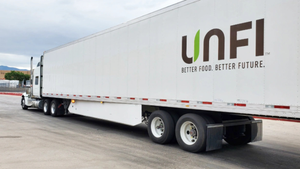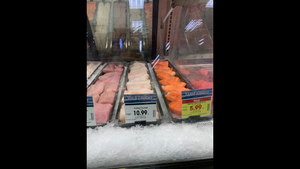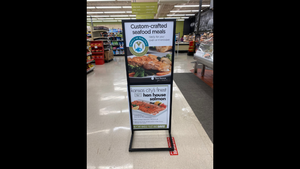Go Grocer's Key to Ultrafast Delivery: Actual, Real-Life Stores
Chicago-born convenience grocer seeks to be a long-term player in quickly evolving space. Go Grocer Co-Founder Paul Stellatos says building out ultrafast delivery from the store up rather than from the app down will set the Chicago-born convenience grocer's delivery business apart.

Paul Stellatos and his brother Greg took the plunge into ultrafast grocery delivery with their Go Grocer business in Chicago last month. The difference between Go Grocer and most of the other players jockeying for position in the nascent instant-delivery space? Go Grocer has actual retail stores—more than a dozen of them. The company's 16th location, a 2,800-square-foot storefront carrying around 4,000 items, opened in Chicago's Lincoln Park neighborhood in October, as reported by Block Club Chicago.
Go Grocer's focus on building from the store up rather than from the app down—in combination with a Midwestern-born, profitability-first mindset—is what will help set the business apart from a growing roster of competitors as it builds up and out, according to Paul Stellatos.
Stellatos spoke recently with WGB about the impetus for jumping into sub-20-minute grocery delivery now, the advantages he sees in Go Grocer's corner-store roots and what's next for the company.
Christine LaFave Grace: Two years ago, the idea of ultrafast grocery delivery wasn't even on a lot of people's radar, and now there's this array of instant-delivery specialists duking it out in New York, and another up-and-comer launching its U.S. business in Chicago earlier this month. What is Go Grocer's play in this fast-growing field?
Paul Stellatos: Go Grocer was just founded as your neighborhood-needed store, your neighborhood convenience store. Our first store was in Wicker Park, and we just sort of boot-strapped it—we opened it, and my brother and I worked the store ourselves. We met our customers and we grew from there. We opened our second location in the South Loop; we opened our third location in Lakeview, one after another we would open up stores.
We started by building our stores first, whereas these rapid delivery services, they built their app first and are now searching for locations. We’ve got 16 locations across the city, built with the notion of just being profitable first. I think that’s what separates us from all of the other companies. Not to put them down by any means, but it’s quite easy to do that stuff when you’re using somebody else’s money and you’re kind of thinking of how to capture market share first rather than being profitable first. We come from that background where we can’t necessarily afford to build that custom app if we don’t have a profitable store and we aren’t making money.
Why did you want to jump specifically into the ultrafast-delivery fray?
The pandemic for us really catapulted us to the new world. We took all of the profits that we made and we put them into this technology, so we essentially are now a software company. We spent about 12 months putting it all together [with a Chicago-based tech vendor].
Why it’s needed in this time is because that’s just the way the world has changed. We are blessed enough to be able to launch in a market where we are pre-New York, right? In New York you have like 10 companies [competing]. We launched about a month ago here in Chicago; we are lucky enough that we have 16 stores with two registers per store, which means we’ve got 32 salesmen selling the app to everybody.
So it’s like, "Welcome to our store; download our new app, we can bring [your order] to your house, bring it to you for free." So in that aspect, we essentially can get customers for free, initially, to get the app rocking and rolling. Amazon and Whole Foods are having a really difficult time trying to get orders to people’s houses in a timely fashion. Same-day deliveries are kind of tough—I’ve got three kids and I have 16 stores, but my wife orders from Whole Foods all the time. And there’s a Whole Foods down the street, so I like to gauge what we do compared to what Whole Foods is doing. When you’re ordering $200 of groceries and you can’t get it the same day—I said to my brother, "This is a red flag." Why are we able to deliver groceries to anywhere in Chicago in less than 15 minutes, but this billion-dollar company down the street can’t get it to me the same day? And now they’re billing everybody $10 for it.
Now, too, you’re seeing consolidation of these companies. We’ve really got a handle on our unit economics because we were forced to. You can’t deliver an apple in seven minutes and be profitable. As much as you want to be, you just can’t be. So that’s what separates us from everybody—we’ve done it properly; all of our stores are profitable. We have an open-floor concept, which allows us to have two tiers of advertising. We get to sell the person the product through the store; we then can sell it through the app at a discounted price or for free delivery or whatever we want to do.
We are a little minnow in a huge sea of sharks, but we are very nimble in our product variety. We have our own warehouse where we make all of our fresh-made prepared foods—we’ve got a menu of 200 items. That’s our No. 1 category.
Speaking as a Midwesterner, this stay-grounded, profitability-first mindset seems to be a very Midwestern kind of ethic; it's something I've heard from other Midwest-based entrepreneurs. Is that something you see?
No one kind of gets it [that you have to be profitable first]—they're like, "Yeah, yeah, yeah, but..." How in your right mind can you create a sustainable business where you can expand on it, you can add stuff to it, you can give the customer what they want, if you aren’t profitable? And the truth is you can’t—you’re just cash-burning at that point. Anybody can cash-burn, which is why you see so many people trying to come into this space.
I go back to talking about unit economics—I come from Europe; my family’s Greek, so we spend the summers in Greece. So the past couple of summers, we chased down the Getirs, we chased down the Gorillas, and I went to some of their warehouses. And then I went two or three storefronts over and I called and asked, how much is rent for this space? And they said, “It’s 400 Euro.” There’s your big a-ha moment: You start from the top, and your rent is your biggest expense. If you’re in Europe, paying 400 Euro, 300 Euro, 600 Euro in rent, and now you want to come to one of the New York boroughs or the 42nd ward of Chicago? You are not paying 800 Euro a month in rent. I’ve got some good friends in real estate, and they’re like, "These companies are coming into Chicago, they’re trying to get leases, and the landlords won’t approve the leases because their finances aren’t there." And I said, there’s the light bulb. If you can’t be profitable here in Chicago, you aren’t going to be profitable as you get to New York or anywhere else.
What’s next for Go Grocer?
We launched our app about a month ago; we are seeing tremendous success with that. We do about 1.2 million transactions a year. What’s next for us is we’ve got a couple more stores we’ve signed leases on in different areas of the city to sort of shore up our backyard, per se. We want to get every neighborhood in Chicago, and we’re just a few months off from that. Then testing the waters to go to different markets across the country. Now we are starting to have conversations with the suit guys, the private-equity guys. The next six months will be head-down, working on the app, making sure all the orders are fulfilled quickly—right now we’re averaging 13 minutes and 20 seconds per order. We threw our hat in this chaos of rapid delivery, [but] sustainability for the long term is easier us because we’re profitable in every stage of what we do. We can pay the bills from our stores.
About the Author
You May Also Like






